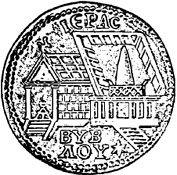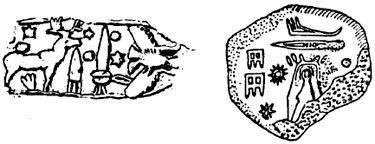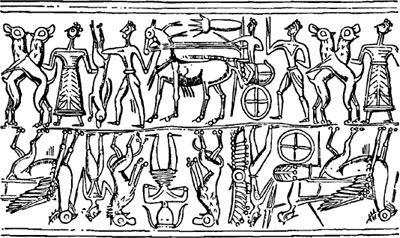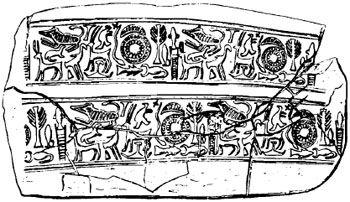The 12th Planet (22 page)
Authors: Zecharia Sitchin
Tags: #Non-Fiction, #Gnostic Dementia, #Fringe Science, #Retail, #Archaeology, #Ancient Aliens, #History

Fig. 66
The ancient texts also describe some vehicle used to lift aeronauts into the skies. Gudea stated that, as the "divine bird" rose to circle the lands, it "flashed upon the raised bricks." The protected enclosure was described as MU.NA.DA.TUR.TUR ("strong stone resting place of the MU"). Urukagina, who ruled in Lagash, said in regard to the "divine black wind bird": "The MU that lights up as a fire I made high and strong." Similarly, Lu-Utu, who ruled in Umma in the third millennium
B.C.
, constructed a place for a
mu,
"which in a fire comes forth," for the god Utu, "in the appointed place within his temple."
The Babylonian king Nebuchadnezzar II, recording his rebuilding of Marduk's sacred precinct, said that within fortified walls made of burned brick and gleaming onyx marble:
I raised the head of the boat ID.GE.UL
the Chariot of Marduk's princeliness;
The boat ZAG.MU.KU, whose approach is observed,
the supreme traveler between Heaven and Earth,
in the midst of the pavilion I enclosed,
screening off its sides.
ID.GE.UL, the first epithet employed to describe this "supreme traveler," or "Chariot of Marduk," literally means "high to heaven, bright at night." ZAG.MU.KU, the second epithet describing the vehicle—clearly a "boat" nesting in a special pavilion—means "the bright MU which is for afar."
That a
mu
—an oval-topped, conical object—was indeed installed in the inner, sacred enclosure of the temples of the Great Gods of Heaven and Earth can, fortunately, be proved. An ancient coin found at Byblos (the biblical Gebal) on the Mediterranean coast of present-day Lebanon depicts the Great Temple of Ishtar. Though shown as it stood in the first millennium
B.C.
, the requirement that temples be built and rebuilt upon the same site and in accordance with the original plan undoubtedly means that we see the basic elements of the original temple of Byblos, traced to millennia earlier.
The coin depicts a two-part temple. In front stands the main temple structure, imposing with its columned gateway. Behind it is. an inner courtyard, or "sacred area," hidden and protected by a high, massive wall. It is clearly a raised area, for it can be reached only by ascending many stairs. (Fig. 67)

Fig. 67
In the center of this sacred area stands a special platform, its crossbeam construction resembling that of the Eiffel Tower, as though built to withstand great weight. And on the platform stands the object of all this security and protection: an object that can only be a
mu.
Like most Sumerian syllabic words,
mu
had a primary meaning; in the case of
mu,
it was "that which rises straight." Its thirty-odd nuances encompassed the meanings "heights," "fire," "command," "a counted period," as well as (in later times) "that by which one is remembered." If we trace the written sign for
mu
from its Assyrian and Babylonian cuneiform stylizations to its original Sumerian pictographs, the following pictorial evidence emerges:

We clearly see a conical chamber, depicted by itself or with a narrow section attached to it. "From a golden chamber-in-the-sky I will watch over thee," Inanna promised to the Assyrian king. Was this
mu
the "heavenly chamber"?
A hymn to Inanna/Ishtar and her journeys in the Boat of Heaven clearly indicates that the
mu
was the vehicle in which the gods roamed the skies far and high:
Lady of Heaven:
She puts on the Garment of Heaven;
She valiantly ascends towards Heaven.
Over all the peopled lands
she flies in her MU.
Lady, who in her MU
to the heights of Heaven joyfully wings.
Over all the resting places
she flies in her MU.
There is evidence to show that the people of the eastern Mediterranean had seen such a rocket-like object not only in a temple enclosure but actually in flight. Hittite glyphs, for example, showed—against a background of starry heavens—cruising missiles, rockets mounted on launch pads, and a god inside a radiating chamber. (Fig. 68)

Fig. 68
Professor H. Frankfort
(Cylinder Seals),
demonstrating how both the art of making the Mesopotamian cylinder seals and the subjects depicted on them spread throughout the ancient world, reproduces the design on a seal found in Crete and dated to the thirteenth century
B.C.
The seal design clearly depicts a rocket ship moving in the skies and propelled by flames escaping from its rear. (Fig. 69)
The winged horses, the entwined animals, the winged celestial globe, and the deity with horns protruding from his headdress are all known Mesopotamian themes. It can certainly be assumed that the fiery rocket shown on the Cretan seal was also an object familiar throughout the ancient Near East.

Fig. 69

Fig. 70
Indeed, a rocket with "wings" or fins—reachable by a "ladder"—can be seen on a tablet excavated at Gezer, a town in ancient Canaan, west of Jerusalem. The double imprint of the same seal also shows a rocket resting on the ground next to a palm tree. The celestial nature or destination of the objects is attested by symbols of the Sun, Moon, and zodiacal constellations that adorn the seal. (Fig. 70)
•
The Mesopotamian texts that refer to the inner enclosures of temples, or to the heavenly journeys of the gods, or even to instances where mortals ascended to the heavens, employ the Sumerian term
mu
or its Semitic derivatives
shu-mu
("that which is a
mu'?, sham,
or
shem.
Because the term also connoted "that by which one is remembered," the word has come to be taken as meaning "name." But the universal application of "name" to early texts that spoke of an object used in flying has obscured the true meaning of the ancient records.
Thus G. A. Barton
(The Royal Inscriptions of Sumer and Akkad)
established the unchallenged translation of Gudea's temple inscription—that "Its MU shall hug the lands from horizon to horizon"—as "Its
name
shall fill the lands." A hymn to Ishkur, extolling his "ray-emitting MU" that could attain the heights of Heaven, was likewise rendered: "Thy
name
is radiant, it reaches Heaven's zenith." Sensing, however, that
mu
or
shem
may mean an object and not "name," some scholars have treated the term as a suffix or grammatical phenomenon not requiring translation and have thereby avoided the issue altogether.
It is not too difficult to trace the etymology of the term, and the route by which the "sky chamber" assumed the meaning of "name." Sculptures have been found that show a god inside a rocket-shaped chamber, as in this object of extreme antiquity (now in the possession of the University Museum, Philadelphia) where the celestial nature of the chamber is attested by the twelve globes decorating it. (Fig. 71)
Many seals similarly depict a god (and sometimes two) within such oval "divine chambers"; in most instances, these gods within their sacred ovals were depicted as objects of veneration.
Wishing to worship their gods throughout the lands, and not only at the official "house" of each deity, the ancient peoples developed the custom of setting up imitations of the god within his divine "sky chamber." Stone pillars shaped to simulate the oval vehicle were erected at selected sites, and the image of the god was carved into the stone to indicate that he was within the object.
It was only a matter of time before kings and rulers—associating these pillars (called stelae) with the ability to ascend to the Heavenly Abode—began to carve their own images upon the stelae as a way of associating themselves with the Eternal Abode. If they could not escape a physical oblivion, it was important that at least their "name" be forever commemorated. (Fig. 72)
